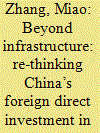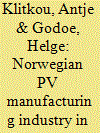| Srl | Item |
| 1 |
ID:
185558


|
|
|
|
|
| Summary/Abstract |
Using a non-state-owned Chinese company LONGi as a case study, this paper analyses the motives, impact and acceptance of Chinese investment in Malaysia. The paper compares Chinese investment in manufacturing sector with the ones in infrastructure sector to obtain a more rigorous assessment than previous studies. In contrast to the narrative depicting Chinese investment into a single superstructure that generates a monolithic and deleterious impact couched under the Belt and Road Initiative, I argue that the motives and impacts of Chinese investment vary significantly with business nature and practices, and thus generating different acceptance level towards Chinese-funded project in host-site. LONGi’s case elucidates why Chinese investment in manufacturing encountered little political upheaval, while BRI projects in infrastructure sectors are often disputed. The analytical benefits and policy implications arising from this specific case study of Malaysia should be helpful to deepen our understanding of Chinese outward investment in not only other emerging economies in ASEAN but also broader region of the Asia-Pacific.
|
|
|
|
|
|
|
|
|
|
|
|
|
|
|
|
| 2 |
ID:
180853


|
|
|
|
|
| Summary/Abstract |
Many countries have implemented incentive policies to support green R & D. However, the behavior of enterprises using the information asymmetry between government and enterprises to camouflage green R & D and obtain preferential policies will lead to the failure of policies. In order to explore the effectiveness of policies in stimulating green R & D, this paper studies the diffusion of green R & D in the photovoltaic industry under different scenarios of incentives and supervision. The results show that: (1) improving regulatory capacity or punishment can inhibit the behavior of enterprises camouflage as green R & D. (2) Under current policies, R & D tax incentives increasing has no obvious effect on the diffusion of green R & D. (3) When implementing the green R & D quota system (GRDQS), the diffusion of green R & D can be deduced under model, even if the R & D tax preference is cancelled. Based on our model, we believe that the GRDQS is an effective means to encourage the photovoltaic industry to carry out green R & D.
|
|
|
|
|
|
|
|
|
|
|
|
|
|
|
|
| 3 |
ID:
125688


|
|
|
|
|
| Publication |
2013.
|
| Summary/Abstract |
For the benefit of our common future, policies aimed at the development and promotion of renewable energy technologies should be based on a Triple Helix approach with a sense of technological agency. This view is supported by a case study on the emergence and development of a Norwegian solar photovoltaic manufacturing industry. The data and analyses demonstrate how this new industry was fostered by interactions between existing companies, public R&D funding programmes and research organisations and policy contexts; illustrating a policy-driven technological agency in accordance with a Triple Helix innovation process. During the last decade, a solar PV manufacturing industry has emerged in Norway and gone on to a 10 to 20 per cent share of various segments of world markets for solar PV feedstock, wafers and related components. The present financial crisis has caused an investment slump in solar PV installations, especially in Europe. Therefore, the future prospects for the Norwegian solar PV industry are at risk despite of its focus on innovation and R&D, and its technological agency. Political action is needed: (1) creation of market incentives in near markets for the deployment of solar PV, (2) international cooperation for boosting deployment of solar PV in developing countries.
|
|
|
|
|
|
|
|
|
|
|
|
|
|
|
|